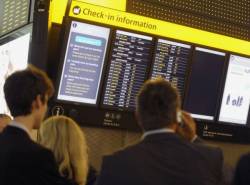
New measures developed by the Civil Aviation Authority (CAA) are due to come into force today in an effort to reduce disruption caused by volcanic ash.
Following “positive” talks between airlines, regulators, and aircraft and engine manufacturers, the CAA has developed a new Time Limited Zone (TLZ), allowing aircraft to fly through higher volumes of ash for shorter periods.
Based on new research, aircraft and engine manufacturers have agreed it is safe to allow operations in the new zone for a limited time, reducing the need for full air space closures.
To operate in the new zone airlines need to present the CAA with a safety case that includes the agreement of their aircraft and engine manufacturers.
UK airline Flybe is the first to achieve this and will therefore be able to use the new zone from midday today.
CAA Criticism
While all UK airspace is presently open, the CAA has come into strong criticism from airlines following the repeated closure of UK airspace in April and May.
British Airways’ chief executive Willie Walsh earlier branded closures “a gross over-reaction” to a “very minor” risk.
Virgin Atlantic president Sir Richard Branson called the closure of Manchester airport on Sunday “beyond a joke”, while Ryanair chief executive Michael O’Leary has said reliance on “outdated, inappropriate and imaginary” computer-generated volcano concentration charts is “ridiculous”.
New Measures
Announcing the change CAA chief executive, Andrew Haines, said: “Unprecedented situations require new measures and the challenge faced should not be underestimated.
“Firstly because the standard default procedure for aircraft that encounter ash, to avoid it completely, doesn’t work in our congested airspace.
“Secondly, the world’s top scientists tell us that we must not simply assume the effects of this volcano will be the same as others elsewhere.
“Its proximity to the UK, the length of time it is continuously erupting and the weather patterns are all exceptional features.”
The introduction of the TLZ is based on measurements collected from test flights through the current ash cloud over the past month, as well as on data and evidence compiled and analysed from previous volcanic ash incidents combined with additional analysis from manufacturers.
Operations in the newly established zone may be subject to time limits and increased maintenance practices.
The new Zone’s area will be established using Met Office forecasts, and will be approved by the CAA before operations are allowed within it.
No comments:
Post a Comment